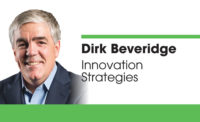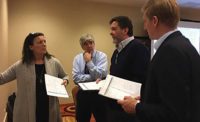One of the thingsthat reinforces the value of ASA membership is the outstanding training content it has built — and continues to update — over the years.
The focus always has been on staying “relevant” and delivering needed learning resources with best-in-class content created by the industry, for the industry. That drumbeat by the ASA Education Foundation’s Board of Trustees has echoed throughout the years as countless volunteers have rotated on and off the board, but
have kept true to the mission. And it continues today.
Yet, everyone knows the old adage about leading a horse to water. Even if someone creates the perfect widget that adds tremendous value, and even if they provide it at a great price, there still will be people that don’t use it. So, we need to build the perfect “water delivery device” for the horse and make it easier for them to drink! That should be a simple task for people in our industry, right?
ASA-U Advisory Service
The Advisory Service from ASA University was created three years ago to assist members in their learning and talent development processes. In essence, it is the horse’s “water delivery device.” Members who may not know where to start in their learning efforts can engage with ASA-U staff to help build and implement the plan for their company. Further, members who have training efforts that have fizzled out or aren’t achieving the results they intended can use ASA-U staff to modify, refresh and get their efforts on track.
Each Advisory Service engagement is different depending on the needs of the members. Some focus on training and identifying what courses are of most benefit to their employees. This customization can ensure the most efficient use of its training spend. While ASA-U already has done this in general, some members want to tweak them even further to their particular needs.
Still other members go a step deeper. They use the assessment documents to assist managers in tailoring training content to the individual level. This provides each employee a personal list of courses based on their on-the-job performance. Gaps are identified by manager observations. Those gaps are then linked to training content.
In this scenario, ASA-U provides the help and education for the managers to learn how to conduct on-the-job evaluations and position the needed training to the employee. When course selections are created specifically for an individual, the organization knows the training being deployed is the most relevant.
The Advisory Model
When ASA-U begins the Advisory process, the discussion starts using the engagement model for Talent Development (see graphic above). There are six levels to the model and each connects to the top level of Learning Management. Member companies assess their current state at each level and determine where their focus will be with assistance from ASA-U staff.
The foundational level is Job Descriptions. It is critical to accurately define the requirements of the job. Many members have job descriptions, but may not have updated them to reflect changes in technology, new product lines, adjusted task assignments, etc. Once job descriptions are updated, they should be connected to learning opportunities or branch-specific procedures.
The next level is Assessments. These are objective third-party appraisals of a candidate’s or employee’s fitness to the role. They assist managers when hiring external candidates or internal transfers. They give more concrete guidance on whether
someone is a fit to the role other than “I
liked the person!”
The third is the Competency level. Competencies create a common language in the organization and learning can be attached to them. Things such as customer focus, quality orientation, persuasiveness and decision-making all are examples. Since courses support them, they become the connection to learning.
The Behaviors level breaks down the competencies into on-the-job descriptions of required behaviors for a particular role. Here, detail of what success looks like is available to managers and employees. Comparing the descriptions with what the employee is doing on the job allows training to quickly be identified.
By the Performance Management level, managers are able to have formal discussions with employees on their progress against an established set of goals. This is where the return on investment becomes important. Again, learning is discussed where there
are gaps in converting daily activities
into results.
In order to maximize the value of training and development efforts, all levels should be tied to Learning Management. Without the connections, there is a greater risk in wasted or disconnected learning. This top level helps the organization and its employees see that training is an ongoing process, not a moment in time.
The ASA-U Advisory Service helps organizations within our industry to navigate through these different levels, make the critical connections between them and map out a multiyear training effort that will have measurable business results.
The power of customization
Todd Pipe, a plumbing distributor based in Anaheim, Calif., launched Todd Pipe University earlier this year using the ASA-U Advisory Service to help in the development and rollout process. President/CEO Dan Patrick describes his aim for the project, “We will have the best-trained staff in our sales territory.”
Yet, instead of simply taking ASA-U and Eclipse content off-the-shelf and rolling it out to everyone, the ownership and HR teams set out to tailor it to Todd Pipe’s specific needs. Patrick continues: “We thought if we’d customize the course lists to our company, we’d have higher buy-in. We knew ASA-U would present it to our team in a professional way. If we shot-gunned it without the extra work up front (to customize the course list), we wouldn’t have the buy-in.”
The managers each took at least one course to understand what they’d be asking their employees to do. They were able to witness the importance of time away from the job to complete the courses and getting a feel for the content. Representatives of the owners then went on a “roadshow” to share what was going to happen, what the organizational commitment was, how it would benefit the employees and customers, and what was expected of employees.
Patrick continued: “Our team needed to
see it was important that senior leadership was involved from the beginning. If we simply outsourced it, it wouldn’t have the same impact.”
Joint effort
Most engagements begin with at least one scheduled phone call with the owner, president or other champion in the business. During this, the scope of the agreement is defined. Objectives, strategies, an action plan and potential milestone dates are discussed. The result is a formal scope of work that ASA-U staff produces a few days following the call.
Adjustments can be made to the scope, and when all is finalized, the engagement begins. Usually, an on-site visit by ASA-U staff is the next step. Members can expect ASA-U staff to meet with all the relevant people within their business for the purposes of data collection.
The member chooses a point person within the organization to be the liaison with staff. This can be the president/owner or a representative of the leadership team. Correspondences, sign-offs and project management tasks that hold internal employees accountable to deadlines are just some of the responsibilities for this role.
ASA-U staff funnels the action items through the member point person. From there, decisions, document reviews, suggestions, etc., become disseminated for continued progress. The member determines the phase-gate sign-offs preferred, and the expected deadlines are determined by both the members and ASA-U staff.
Depending on the project scope, return
visits by ASA-U staff may be required to continue the rollout or assist managers in the change-management aspects of the engagement. Other, more limited scope engagements may be largely complete following the initial onsite visit.
A Wholesaler’s University
Two ASA-member companies used ASA-U to help them create their own version of a university. Besides Todd Pipe, Bakersfield, Calif.-based PVF wholesaler Bakersfield Pipe and Supply also has enlisted
ASA-U’s services.
BPS launched its university model by providing eLearning courses to all its employees. It started with all warehouse employees and then moved to inside sales associates. This role-based rollout made the most sense for BPS to ensure the best use of time. Prior to each rollout, members of the management team previewed and selected the specific eLearning modules for their employees. Brad Whittington, process manager and a 30-year veteran of the organization, commented: “Once we identified what was needed and worked with ASA-U to tailor the course lists, the benefits have been huge. It takes some time upfront, but it’s time well-spent.”
BPS deployed an ASA-U best practice of installing a “learning kiosk” in each branch. This is a separate area or room with a PC dedicated to learning. Employees are assigned “learning time” and login at the learning kiosk to take their courses. Since these are positioned in a more secluded part of the branch, there are fewer interruptions and employees can spend their time focused on the course.
The amount of assigned learning time and frequency varies from employee to employee. Anticipating some initial resistance to the program, Whittington was pleasantly surprised when it was minimal. “We haven’t seen much skepticism from managers and employees in taking the courses. Initially, managers were saying ‘I don’t know how to fit this in,’ but we let the branches schedule it the way that made sense for them. There was no pushback on content; there were nice compliments and people said they were very helpful courses.”
Same animal, different stripes
Wholesalers in our industry largely have similar challenges, similar roles and similar training needs. Yet, they may be at different stages in their talent development. That’s how the ASA-U Advisory Service’s flexible model can lend industry expertise to a specific wholesaler’s needs. Each engagement is different, depending on the member’s needs and their efforts to date.
Some already are doing quite a bit of training, but they want to ensure their efforts are headed in the right direction. Others are not training and have put it off, not knowing where to start. Amy Black, executive director of ASA-U, says: “We hear it all the time from members in our industry: ‘You guys have great content. I just don’t know where to start. Or, I don’t have the time or knowledge to get started.’ That’s what the ASA-U Advisory Service is
all about!”
More Information
To learn more, visit ASA-U Advisory Service online, or call an ASA-U advisor at 630/467-0000, ext. 111.
About the Author:Doug Dillonis director of professional development for ASA-U. He has 20 years of experience in the learning, OD and leadership-development areas. Twelve of those years have been in the plumbing, PVF and HVAC industry. He has authored industry-leading talent programs and has been a featured speaker at past ASA and ATD (Association for Talent Development) conventions.








